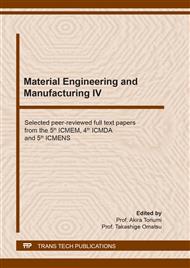[1]
A. Minnich and G. Chen, Modified effective medium formulation for the thermal conductivity of nanocomposites,, Appl. Phys. Lett., vol. 91, no. 7, p.17–20, 2007,.
DOI: 10.1063/1.2771040
Google Scholar
[2]
L. Lindsay, A. Katre, A. Cepellotti, and N. Mingo, Perspective on ab initio phonon thermal transport,, J. Appl. Phys., vol. 126, no. 5, p.050902, Aug. 2019,.
DOI: 10.1063/1.5108651
Google Scholar
[3]
G. Fugallo and L. Colombo, Calculating lattice thermal conductivity: A synopsis,, Phys. Scr., vol. 93, no. 4, p.43002, (2018).
DOI: 10.1088/1402-4896/aab743
Google Scholar
[4]
D. A. Broido, M. Malorny, G. Birner, N. Mingo, and D. A. Stewart, Intrinsic lattice thermal conductivity of semiconductors from first principles,, Appl. Phys. Lett., vol. 91, no. 23, (2007).
DOI: 10.1063/1.2822891
Google Scholar
[5]
L. Lindsay, D. A. Broido, and T. L. Reinecke, First-principles determination of ultrahigh thermal conductivity of boron arsenide:A competitor for diamond, Phys. Rev. Lett., vol. 111, no. 2, p.1–5, (2013).
DOI: 10.1103/physrevlett.111.025901
Google Scholar
[6]
K. Esfarjani and H. T. Stokes, Method to extract anharmonic force constants from first principles calculations,, Phys. Rev. B - Condens. Matter Mater. Phys., vol. 77, no. 14, p.1–7, (2008).
DOI: 10.1103/physrevb.77.144112
Google Scholar
[7]
S. Baroni, S. De Gironcoli, A. Dal Corso, and P. Giannozzi, Phonons and related crystal properties from density-functional perturbation theory,, Reviews of Modern Physics. (2001).
DOI: 10.1103/revmodphys.73.515
Google Scholar
[8]
G. Deinzer, G. Birner, and D. Strauch, Ab initio calculation of the linewidth of various phonon modes in germanium and silicon,, Phys. Rev. B, vol. 67, no. 14, p.144304, Apr. (2003).
DOI: 10.1103/physrevb.67.144304
Google Scholar
[9]
J. P. Perdew, A. Ruzsinszky, J. Tao, V. N. Staroverov, G. E. Scuseria, and G. I. Csonka, Prescription for the design and selection of density functional approximations: More constraint satisfaction with fewer fits,, J. Chem. Phys., vol. 123, no. 6, (2005).
DOI: 10.1063/1.1904565
Google Scholar
[10]
S. Baroni, S. de Gironcoli, A. Dal Corso, and P. Giannozzi, Phonons and related crystal properties from density-functional perturbation theory,, Rev. Mod. Phys., vol. 73, no. 2, p.515–562, Jul. (2001).
DOI: 10.1103/revmodphys.73.515
Google Scholar
[11]
P. Giannozzi et al., QUANTUM ESPRESSO: A modular and open-source software project for quantum simulations of materials,, J. Phys. Condens. Matter, vol. 21, no. 39, (2009).
Google Scholar
[12]
J. Hafner, Ab-initio simulations of materials using VASP: Density-functional theory and beyond,, J. Comput. Chem., vol. 29, no. 13, p.2044–2078, Oct. (2008).
DOI: 10.1002/jcc.21057
Google Scholar
[13]
X. Gonze et al., ABINIT: First-principles approach to material and nanosystem properties,, Comput. Phys. Commun., vol. 180, no. 12, p.2582–2615, Dec. (2009).
Google Scholar
[14]
J. E. Turney, E. S. Landry, A. J. H. McGaughey, and C. H. Amon, Predicting phonon properties and thermal conductivity from anharmonic lattice dynamics calculations and molecular dynamics simulations,, Phys. Rev. B - Condens. Matter Mater. Phys., vol. 79, no. 6, p.1–12, (2009).
DOI: 10.1103/physrevb.79.064301
Google Scholar
[15]
T. Feng, L. Lindsay, and X. Ruan, Four-phonon scattering significantly reduces intrinsic thermal conductivity of solids,, Phys. Rev. B, vol. 96, no. 16, p.1–6, (2017).
DOI: 10.1103/physrevb.96.161201
Google Scholar
[16]
T. Feng and X. Ruan, Quantum mechanical prediction of four-phonon scattering rates and reduced thermal conductivity of solids,, Phys. Rev. B, vol. 93, no. 4, p.1–10, (2016).
DOI: 10.1103/physrevb.93.045202
Google Scholar
[17]
A. Chernatynskiy and S. R. Phillpot, Evaluation of computational techniques for solving the Boltzmann transport equation for lattice thermal conductivity calculations,, Phys. Rev. B - Condens. Matter Mater. Phys., vol. 82, no. 13, p.1–17, (2010).
DOI: 10.1103/physrevb.82.134301
Google Scholar
[18]
S. Pettersson, Solving the phonon Boltzmann equation with the variational method,, Phys. Rev. B, vol. 43, no. 11, p.9238–9246, Apr. (1991).
DOI: 10.1103/physrevb.43.9238
Google Scholar
[19]
W. Li, N. A. Katcho, and N. Mingo, ShengBTE : A solver of the Boltzmann transport equation,, vol. 185, p.1747–1758, (2014).
DOI: 10.1016/j.cpc.2014.02.015
Google Scholar
[20]
A. Togo, L. Chaput, and I. Tanaka, Distributions of phonon lifetimes in Brillouin zones,, vol. 094306, (2015).
Google Scholar
[21]
J. Carrete et al., almaBTE : a solver of the space-time dependent Boltzmann transport equation for phonons in structured materials,, Comput. Phys. Commun., (2017).
DOI: 10.1016/j.cpc.2017.06.023
Google Scholar
[22]
T. Tadano, Y. Gohda, and S. Tsuneyuki, Anharmonic force constants extracted from first-principles molecular dynamics: applications to heat transfer simulations,, J. Phys. Condens. Matter, vol. 26, no. 22, p.225402, (2014).
DOI: 10.1088/0953-8984/26/22/225402
Google Scholar
[23]
Feng, L. Lindsay, and X. Ruan, Four-phonon scattering significantly reduces intrinsic thermal conductivity of solids,, vol. 161201, p.1–6, (2017).
DOI: 10.1103/physrevb.96.161201
Google Scholar
[24]
S. Li et al., High thermal conductivity in cubic boron arsenide crystals,, Science, vol. 361, no. 6402, p.579–581, (2018).
DOI: 10.1126/science.aat8982
Google Scholar
[25]
Q. Zheng et al., High Thermal Conductivity in Isotopically Enriched Cubic Boron Phosphide,, Adv. Funct. Mater., vol. 28, no. 43, p.1–9, (2018).
DOI: 10.1002/adfm.201805116
Google Scholar
[26]
J. S. Kang, M. Li, H. Wu, H. Nguyen, and Y. Hu, Experimental observation of high thermal conductivity in boron arsenide,, Science (80-. )., vol. 361, no. 6402, p.575–578, (2018).
DOI: 10.1126/science.aat5522
Google Scholar


